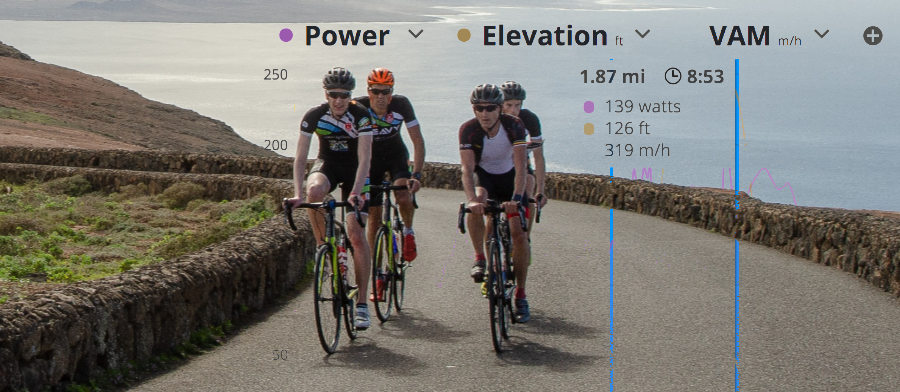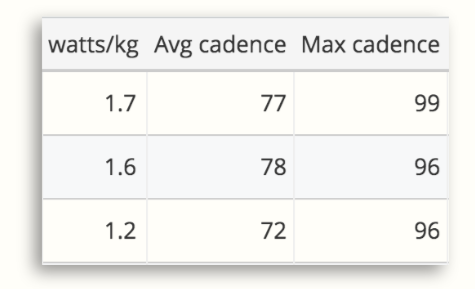Biking Up the Mountain
How to train to become a better climber in cycling
Do you only ride on flat routes? Do you shift gears just to speed up and slow down? Does the largest cog on your rear cassette get the least amount of use? If you answered yes to these questions, this article may not be for you because it's about the specialized skill of climbing in cycling. We look at factors that make it so challenging, and show you the metrics to focus on for improvement.
Gravity: The force is against you
The same thing that keeps your coffee mug planted on the desk beside you is what makes climbing so difficult: gravity. There's no better reminder that you're not riding an eBike, moped, or Harley Davidson than pushing the cranks on a steep incline. Even a short, low-grade hill is enough bring inexperienced bike riders to a complete stop.

The steeper the hill, the more difficult it gets to fight gravity and climb upward. There are adjustments you can make that help ease this burden. You can get a bike that was designed for climbing, which essentially means it uses the most lightweight components in its price class. You can also opt to wear minimal kit, only carry necessary items, and to use a compact bike computer.
When you have all of the "weight weenie" aspects of the ride figured out, the only things left to improve are your body and mind, and working on these two items will go much further than shaving a few grams off your bike. An essential requirement here is to optimize your cycling form, reducing inefficient motions and habits as much as possible. Mentally, you need to proactively avoid negative thoughts. Long, repetitive climbs can wreak havoc on your mental game.
Keep those legs spinning
Lots of energy is required to turn your pedals when going uphill, which can transform a ride from a slowtwitch-muscle endurance workout into a fast-twitch effort. If you've got a decent amount of climbing to do, it's best to try to keep it in endurance mode by maintaining a high cadence. Cadence is the number of times you spin your pedals in a minute, and keeping it above 85 RPM will provide more of a cardiovascular workout and keep your legs fresher by avoiding the buildup of lactic acid.
| Learn more about cadence and how to improve it in our What Is Good Cycling Cadence article. |
In order to track cadence on your bike, you can count pedal strokes in your head, or you can use a cadence sensor paired with your sports watch or bike computer. It's extremely beneficial to keep an eye on your cadence as you ride, as it's common to start dropping your cadence number without realizing it. It's also helpful to analyze your cadence data after your workout. SportTracks makes it easy to compare two rides, so you can see if your cadence numbers are maintaining or increasing on the same hill over time.
The power of watts/kg
If your bike is outfitted with a power meter, you have access to one of the most useful metrics for improving performance on the hills: watts/kg. This is your power output relative to weight (it stands for watts per kilogram). This number helps coaches compare one rider against another, but on the individual level it can help you understand if your training adaptations are successfully making you more powerful on the mountain.
The beauty of watts/kg is that it's both simple to understand, and incredibly meaningful. If you're getting more powerful at the same weight, you're making progress. If you're getting more powerful at a lower weight, you're going to make substantial gains on climbs. This is yet another area where it's beneficial to ride the same routes and hills for workout comparison. SportTracks provides your watts/kg on workout detail pages, and you can add this metric to your Workouts page with other data to look for trends.

VAM = Vertical cycling speed
Another way to capitalize on riding the same routes for comparison is to analyze your VAM. This metric was born for the hills as it measures your vertical speed, letting you know how many meters you climbed per hour. No dedicated hardware sensors are required to track VAM, as SportTracks automatically calculates it and adds it to any workout with GPS data. You can learn all about it in our Using VAM in Cycling article.
Riding hills is a reliable way to get fresh air and take in well-earned views and vistas, but if your primary goal is to improve, you need to intentionally target specific metrics. Threshold training benefits all kinds of cycling disciplines, and it's also effective in the hills. FTP (Functional Threshold Power) is the maximum power you can hold for one hour without slowing down. Regularly executing workouts that target your current Cycling FTP will help you power up hills, however, to gain this edge dedication and consistency are required.
Regular strength-training routines throughout each week are also key to unlocking your climbing potential. But don't pump iron like a bodybuilder, you need to focus on cycling-specific exercises. To erase any guesswork, start with the drills covered in our article about improving bike power.
As you intentionally train in all of the areas covered in this article, always keep proper cycling form top of mind as you ride. Your upper body needs to remain relaxed. Your breathing should be deep and controlled. You need to stay in the saddle, no matter how steep the incline. And as you train physically, use the stress to improve your mental game.
Thanks for reading this post! For more training tips check out our other cycling articles.
| Article written by Sam Mallery, Director of Marketing, Zone Five Software Inc. |
